-
PDF
- Split View
-
Views
-
Cite
Cite
Xin-Hua Gao, Membership and fundamental parameters of the intermediate-age open clusters NGC 2281 and NGC 2539 based on Gaia-DR2, Publications of the Astronomical Society of Japan, Volume 71, Issue 3, June 2019, 62, https://doi.org/10.1093/pasj/psz039
Close - Share Icon Share
Abstract
This paper presents an investigation on the two intermediate-age open clusters NGC 2281 and NGC 2539 based on Gaia Data Release 2 (Gaia-DR2). A combined machine-learning method is used to identify likely cluster members of the two clusters, taking into account the astrometric and photometric data of Gaia-DR2. It is found that NGC 2281 and NGC 2539 each have more than 600 likely cluster members, which are highly suitable for further investigation of the fundamental parameters of the two clusters. Robust estimates of the distances, proper motions, and radial velocities for the two clusters are obtained via a Monte Carlo simulation technique. NGC 2281 is found to have a distance of 522|$\, \pm \,$|12 pc, a proper motion of (〈μαcos δ〉, 〈μδ〉) = (|$-2.947\, \pm \,$|0.014, |$-8.344\, \pm \,$|0.014) mas yr−1, and a radial velocity of |$+20.0\, \pm \,$|0.7 km s−1. The distance, proper motion, and radial velocity of NGC 2539 are determined to be 1271|$\, \pm \,$|70 pc, (〈μαcos δ〉, 〈μδ〉) = (|$-2.335\, \pm \,$|0.007, |$-0.583\, \pm \,$|0.006) mas yr−1, and |$+29.6\, \pm \,$|0.4 km s−1, respectively. We find that NGC 2281 has a core radius of |${8{^{\prime}_{.}}89}$||$\, \pm \,$||${0{^{\prime}_{.}}27}$| (1.3 pc) and a limiting radius of |${79{^{\prime}_{.}}26}$||$\, \pm \,$||${2{^{\prime}_{.}}86}$| (12.0 pc). The core and limiting radius of NGC 2539 are determined to be |${5{^{\prime}_{.}}62}$||$\, \pm \,$||${0{^{\prime}_{.}}28}$| (2.1 pc) and |${33{^{\prime}_{.}}65}$||$\, \pm \,$||${1{^{\prime}_{.}}96}$| (12.4 pc), respectively. In addition, we find strong evidence for the existence of mass segregation in the two clusters.
1 Introduction
Open clusters are powerful tools for studying various astrophysical problems. Intermediate-age and old open clusters are particularly important for investigating the chemical evolution and structure of the Galactic disk (Friel & Janes 1993; Friel 1995). NGC 2281 (|$l= {174{^{\circ}_{.}}901}$|, |$b = +{16{^{\circ}_{.}}881}$|)1 and NGC 2539 (|$l = {233{^{\circ}_{.}}705}$|, |$b= +{11{^{\circ}_{.}}112}$|) are two intermediate-age (500–600 Myr; Dias et al. 2002; Kharchenko et al. 2013) open clusters situated in the direction of the Galactic anticenter, at intermediate Galactic latitudes. Therefore, the field star contamination in the directions of the two clusters is not very heavy. Several authors have investigated the two clusters based on photometric data and determined their photometric distances (Yoshizawa 1978; Claría & Lapasset 1986; Joshi & Sagar 1986; Choo et al. 2003; Kiron et al. 2012). However, the fundamental astrophysical parameters of the two clusters are still poorly constrained. For instance, their sizes still remain unclear, and the only investigation on the spatial structure of the two clusters was carried out by Kharchenko et al. (2013). Accurate membership identification is a critical task for studies of open clusters. However, the membership of the two clusters has not been determined well so far. Kharchenko et al. (2013) determined 193 and 455 likely cluster members for NGC 2281 and NGC 2539, respectively. Recently, Cantat-Gaudin et al. (2018) determined 414 and 518 likely members brighter than G = 18 mag for NGC 2281 and NGC 2539, respectively. Faint (or low-mass) cluster members (G > 18 mag) in the two clusters have not been investigated well yet. Low-mass cluster members are especially important for investigating the dynamical history of an intermediate-age open cluster (e.g., dynamical mass segregation and stellar evaporation). Fortunately, Gaia Data Release 2 (Gaia-DR2; Gaia Collaboration 2016, 2018a) provides a good chance for us to investigate a large number of open clusters (Gaia Collaboration 2018b; Cantat-Gaudin et al. 2018).
Our main motivation in this paper is to more precisely determine the fundamental astrophysical parameters of NGC 2281 and NGC 2539 based on the high-precision astrometric and photometric data of Gaia-DR2. For this purpose, we will use a combined machine-learning (ML) method (Gao 2018a) to identify reliable membership of the two clusters. This method allows us to segregate reliable membership of an open cluster in a large, high-dimensional data set, starting from a limited training set (Gao 2018a, 2018b). This is especially important for studies of open clusters in the Gaia era. This paper is organized as follows. The next section describes sample selection and identification of cluster members for the two clusters. In section 3, we investigate the spatial structure and dynamical mass segregation of the clusters. The distances, proper motions, and radial velocities of the two clusters are estimated based on a Monte Carlo simulation technique in section 4. The last section summarizes the main results obtained in this work.
2 Data and method
2.1 Sample selection
Gaia-DR2 contains high-precision astrometric and photometric data for more than 1.3 billion sources over the whole sky (Gaia Collaboration 2018a). Therefore, it is necessary to select appropriate sample stars from Gaia-DR2 for each cluster. According to the central positions, distances, and proper motions of the two clusters in Dias et al. (2002), we select sample stars using the selection criteria listed in table 1. Note that the distance criterion is performed based on the inverse parallax. These selection criteria allow us to reject a large number of field stars. Finally, we obtain 23508 and 17694 sample stars for NGC 2281 and NGC 2539 respectively, and each sample star has five-parameter astrometric solutions (positions, proper motions, and parallax) and three-band photometry (G, BP, and RP).
| Name . | Cluster center . | D D02 . | PM D02 . | μαcos δ . | μδ . | R s . | R d . | N s . |
|---|---|---|---|---|---|---|---|---|
| . | (°) . | (pc) . | (mas yr−1) . | (mas yr−1) . | (mas yr−1) . | (′) . | (pc) . | . |
| NGC 2281 | 102.0708, +41.0783 | 558 | (−2.48, −6.76) | [−10 10] | [−10 10] | 90 | [0 1500] | 23508 |
| NGC 2539 | 122.6542, −12.8183 | 1363 | (−3.20, −1.24) | [−10 10] | [−10 10] | 40 | [500 3000] | 17694 |
| Name . | Cluster center . | D D02 . | PM D02 . | μαcos δ . | μδ . | R s . | R d . | N s . |
|---|---|---|---|---|---|---|---|---|
| . | (°) . | (pc) . | (mas yr−1) . | (mas yr−1) . | (mas yr−1) . | (′) . | (pc) . | . |
| NGC 2281 | 102.0708, +41.0783 | 558 | (−2.48, −6.76) | [−10 10] | [−10 10] | 90 | [0 1500] | 23508 |
| NGC 2539 | 122.6542, −12.8183 | 1363 | (−3.20, −1.24) | [−10 10] | [−10 10] | 40 | [500 3000] | 17694 |
*DD02: The cluster distance in Dias et al. (2002). PMD02: The cluster proper motion in Dias et al. (2002). μαcos δ, μδ: The proper motion range used for selecting sample stars. Rs: The angular radius used for selecting sample stars. Rd: The distance range used for selecting sample stars. Ns: The number of sample stars.
| Name . | Cluster center . | D D02 . | PM D02 . | μαcos δ . | μδ . | R s . | R d . | N s . |
|---|---|---|---|---|---|---|---|---|
| . | (°) . | (pc) . | (mas yr−1) . | (mas yr−1) . | (mas yr−1) . | (′) . | (pc) . | . |
| NGC 2281 | 102.0708, +41.0783 | 558 | (−2.48, −6.76) | [−10 10] | [−10 10] | 90 | [0 1500] | 23508 |
| NGC 2539 | 122.6542, −12.8183 | 1363 | (−3.20, −1.24) | [−10 10] | [−10 10] | 40 | [500 3000] | 17694 |
| Name . | Cluster center . | D D02 . | PM D02 . | μαcos δ . | μδ . | R s . | R d . | N s . |
|---|---|---|---|---|---|---|---|---|
| . | (°) . | (pc) . | (mas yr−1) . | (mas yr−1) . | (mas yr−1) . | (′) . | (pc) . | . |
| NGC 2281 | 102.0708, +41.0783 | 558 | (−2.48, −6.76) | [−10 10] | [−10 10] | 90 | [0 1500] | 23508 |
| NGC 2539 | 122.6542, −12.8183 | 1363 | (−3.20, −1.24) | [−10 10] | [−10 10] | 40 | [500 3000] | 17694 |
*DD02: The cluster distance in Dias et al. (2002). PMD02: The cluster proper motion in Dias et al. (2002). μαcos δ, μδ: The proper motion range used for selecting sample stars. Rs: The angular radius used for selecting sample stars. Rd: The distance range used for selecting sample stars. Ns: The number of sample stars.
2.2 Method
| Name . | R GMM . | N s . | μc . | μf . | C c . | C f . | w c . | w f . |
|---|---|---|---|---|---|---|---|---|
| . | (′) . | . | (mas yr−1) . | (mas yr−1) . | (°) . | (°) . | . | . |
| NGC 2281 | 40 | 5191 | (−2.997, −8.373) | (0.431, −3.328) | (102.0627, 41.0609) | (102.0642, 41.0669) | 0.1013 | 0.8987 |
| NGC 2539 | 19 | 4523 | (−2.321, −0.595) | (−2.178, 0.547) | (122.6579, −12.8328) | (122.6484, −12.8176) | 0.1199 | 0.8801 |
| Name . | R GMM . | N s . | μc . | μf . | C c . | C f . | w c . | w f . |
|---|---|---|---|---|---|---|---|---|
| . | (′) . | . | (mas yr−1) . | (mas yr−1) . | (°) . | (°) . | . | . |
| NGC 2281 | 40 | 5191 | (−2.997, −8.373) | (0.431, −3.328) | (102.0627, 41.0609) | (102.0642, 41.0669) | 0.1013 | 0.8987 |
| NGC 2539 | 19 | 4523 | (−2.321, −0.595) | (−2.178, 0.547) | (122.6579, −12.8328) | (122.6484, −12.8176) | 0.1199 | 0.8801 |
*RGMM: The limited radius within which sample stars have GMM membership probabilities. Ns: The number of sample stars within the limited radius. μc: The mean proper motion of the cluster component. μf: The mean proper motion of the field component. Cc: The central position of the cluster component. Cf: The central position of the field component. wc: The weight of the cluster component. wf: The weight of the field component.
| Name . | R GMM . | N s . | μc . | μf . | C c . | C f . | w c . | w f . |
|---|---|---|---|---|---|---|---|---|
| . | (′) . | . | (mas yr−1) . | (mas yr−1) . | (°) . | (°) . | . | . |
| NGC 2281 | 40 | 5191 | (−2.997, −8.373) | (0.431, −3.328) | (102.0627, 41.0609) | (102.0642, 41.0669) | 0.1013 | 0.8987 |
| NGC 2539 | 19 | 4523 | (−2.321, −0.595) | (−2.178, 0.547) | (122.6579, −12.8328) | (122.6484, −12.8176) | 0.1199 | 0.8801 |
| Name . | R GMM . | N s . | μc . | μf . | C c . | C f . | w c . | w f . |
|---|---|---|---|---|---|---|---|---|
| . | (′) . | . | (mas yr−1) . | (mas yr−1) . | (°) . | (°) . | . | . |
| NGC 2281 | 40 | 5191 | (−2.997, −8.373) | (0.431, −3.328) | (102.0627, 41.0609) | (102.0642, 41.0669) | 0.1013 | 0.8987 |
| NGC 2539 | 19 | 4523 | (−2.321, −0.595) | (−2.178, 0.547) | (122.6579, −12.8328) | (122.6484, −12.8176) | 0.1199 | 0.8801 |
*RGMM: The limited radius within which sample stars have GMM membership probabilities. Ns: The number of sample stars within the limited radius. μc: The mean proper motion of the cluster component. μf: The mean proper motion of the field component. Cc: The central position of the cluster component. Cf: The central position of the field component. wc: The weight of the cluster component. wf: The weight of the field component.
Figure 1 shows the histograms of the GMM membership probabilities for the two clusters. The GMM exhibits good performance in segregating cluster members and field stars within the limited radii of the two clusters (see table 2). For each cluster, only the high-probability members (PGMM ≥ 0.9) and low-probability field stars (PGMM < 0.2) are used to constructed a training set. The training sets of NGC 2281 and NGC 2539 contain 4997 and 4321 sample stars, respectively. Based on the training sets, we can build two RFs to identify likely cluster members for all the sample stars (see subsection 2.1). In this work, we build two RFs using the Python task RandomForestClassifier in the scikit-learn package2 (Pedregosa et al. 2011). For each cluster, the RF is built using 11 parameters, since each sample star in the training set has five astrometric (positions, parallax, proper motions) and six photometric parameters (G, BP, RP, |$\mathit {BP-RP}$|, |$\mathit {BP-G}$|, and |$\mathit {G-RP}$|). The RF for NGC 2281 contains 5000 decision trees, while the one for NGC 2539 contains 4500 decision trees. These numbers are chosen to roughly match the numbers of stars used in the training sets. Each decision tree randomly selects four parameters from the 11 parameters, and makes a definite decision on whether or not a sample star is a cluster member. Note that it is common practice to use |$m\sim \sqrt{N}$| when applying random forests, where m indicates the number of selected parameters and N indicates the total number of parameters. The fundamental parameters of the two RFs are listed in table 3. We use the out-of-bag (OOB) score to evaluate the prediction accuracies of the two RFs, and two high scores are obtained (see table 3), indicating that the RFs have high prediction accuracies. The RFs can also calculate membership probabilities (PRF) for all the sample stars by majority votes, indicating that the RFs can identify more spatially complete cluster members beyond the limited radii (see table 2).

Histograms of the GMM membership probabilities for the sample stars within the limited radii of the two clusters (see table 2). (Color online)
| Name . | N ts . | N tr . | N s . | OOB score . |
|---|---|---|---|---|
| NGC 2281 | 4997 | 5000 | 23508 | 0.999 |
| NGC 2539 | 4321 | 4500 | 17694 | 0.998 |
| Name . | N ts . | N tr . | N s . | OOB score . |
|---|---|---|---|---|
| NGC 2281 | 4997 | 5000 | 23508 | 0.999 |
| NGC 2539 | 4321 | 4500 | 17694 | 0.998 |
*Nts: The number of stars in the training set. Ntr: The number of decision trees in the RF. Ns: The total number of sample stars for the cluster. OOB score: The out-of-bag (OOB) score of the RF.
| Name . | N ts . | N tr . | N s . | OOB score . |
|---|---|---|---|---|
| NGC 2281 | 4997 | 5000 | 23508 | 0.999 |
| NGC 2539 | 4321 | 4500 | 17694 | 0.998 |
| Name . | N ts . | N tr . | N s . | OOB score . |
|---|---|---|---|---|
| NGC 2281 | 4997 | 5000 | 23508 | 0.999 |
| NGC 2539 | 4321 | 4500 | 17694 | 0.998 |
*Nts: The number of stars in the training set. Ntr: The number of decision trees in the RF. Ns: The total number of sample stars for the cluster. OOB score: The out-of-bag (OOB) score of the RF.
2.3 Likely cluster members
Based on the combined ML method (GMM+RF), we determine 696 and 664 likely cluster members with PRF ≥ 0.6 for NGC 2281 and NGC 2539, respectively. Figures 2 and 3 show color–magnitude diagrams (CMDs) and proper motion vector point diagrams (PM-VPDs) of the likely cluster members and field stars in the fields of the two clusters. The CMDs of likely cluster members in the two clusters show well-defined main sequences and turn-off points. Figures 4 and 5 plot the parallax of our likely cluster members versus the distance to the cluster center. The likely cluster members located outside the limited radii can also be identified, indicating that the ML method has a strong prediction ability. It should be noted that Cantat-Gaudin et al. (2018) determined 414 and 518 likely cluster members for NGC 2281 and NGC 2539, respectively. However, they did not take into account faint stars with G > 18 mag. The likely cluster members of NGC 2281 and NGC 2539 (PRF ≥ 0.6) are listed in the Appendix (see tables 7 and 8).
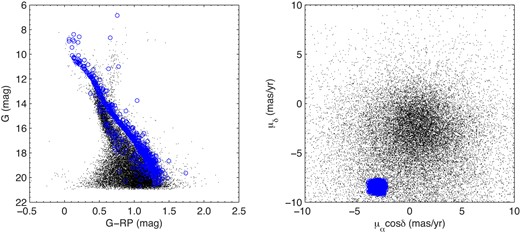
CMDs (left panel) and PM-VPDs (right panel) of the 696 likely cluster members (PRF ≥ 0.6) of NGC 2281 and field stars (PRF < 0.6). In each panel, the blue circles and black dots represent the likely cluster members and field stars, respectively. (Color online)
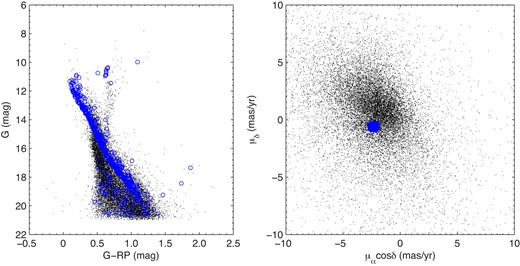
CMDs (left panel) and PM-VPDs (right panel) of the 664 likely cluster members (PRF ≥ 0.6) of NGC 2539 and field stars (PRF < 0.6). The symbols are the same as those in figure 2. (Color online)
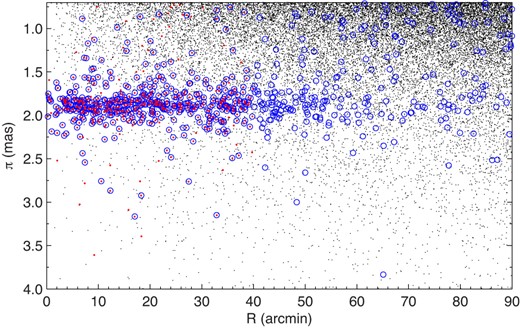
Parallax vs. distance to the cluster center for the 696 likely cluster members of NGC 2281 (PRF ≥ 0.6; blue circles) and field stars (PRF < 0.6; black dots). The red dots indicate the GMM-based likely cluster members (PGMM ≥ 0.6; see subsection 2.2). For illustration purposes, only stars with 0.7 ≤ π ≤ 4 mas (250–1429 pc) are shown in this figure. (Color online)
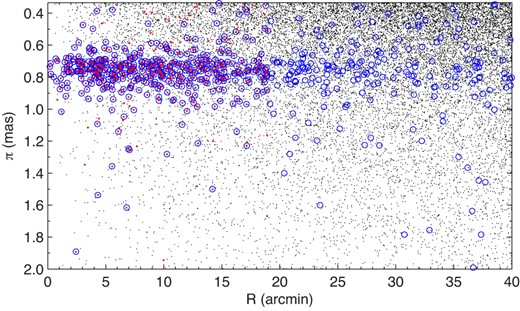
Parallax vs. distance to the cluster center for the 664 likely cluster members of NGC 2539 and field stars. The symbols are the same as those in figure 4. For illustration purposes, only the stars with 0.333 ≤ π ≤ 2 mas (500–3000 pc) are shown in this figure. (Color online)
3 Spatial structure
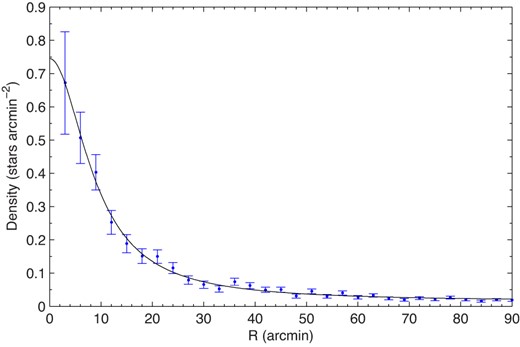
Radial surface density profile of NGC 2811; only stars with PRF ≥ 0.1 are taken into account. The solid curve is a King model fitted to the data, and the error bars represent the 1 σ Poisson errors. (Color online)
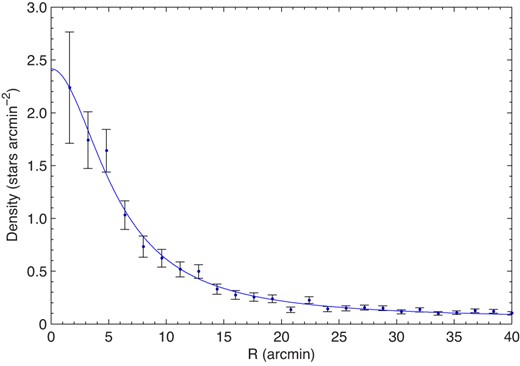
Radial surface density profile of NGC 2539; only stars with PRF ≥ 0.1 are taken into account. The symbols and lines are the same as those in figure 6. (Color online)
| Name . | R c . | R lim . | C* . | ρc . | ρb . |
|---|---|---|---|---|---|
| . | (′) . | (′) . | . | (stars arcmin−2) . | (stars arcmin−2) . |
| NGC 2281 | 8.89|$\, \pm \,$|0.27 | 79.26|$\, \pm \,$|2.86 | 0.95 | 0.73|$\, \pm \,$|0.01 | 0.015|$\, \pm \,$|0.003 |
| NGC 2539 | 5.62|$\, \pm \,$|0.28 | 33.65|$\, \pm \,$|1.96 | 0.78 | 2.37|$\, \pm \,$|0.07 | 0.044|$\, \pm \,$|0.021 |
| Name . | R c . | R lim . | C* . | ρc . | ρb . |
|---|---|---|---|---|---|
| . | (′) . | (′) . | . | (stars arcmin−2) . | (stars arcmin−2) . |
| NGC 2281 | 8.89|$\, \pm \,$|0.27 | 79.26|$\, \pm \,$|2.86 | 0.95 | 0.73|$\, \pm \,$|0.01 | 0.015|$\, \pm \,$|0.003 |
| NGC 2539 | 5.62|$\, \pm \,$|0.28 | 33.65|$\, \pm \,$|1.96 | 0.78 | 2.37|$\, \pm \,$|0.07 | 0.044|$\, \pm \,$|0.021 |
*C: The concentration parameter of the cluster.
| Name . | R c . | R lim . | C* . | ρc . | ρb . |
|---|---|---|---|---|---|
| . | (′) . | (′) . | . | (stars arcmin−2) . | (stars arcmin−2) . |
| NGC 2281 | 8.89|$\, \pm \,$|0.27 | 79.26|$\, \pm \,$|2.86 | 0.95 | 0.73|$\, \pm \,$|0.01 | 0.015|$\, \pm \,$|0.003 |
| NGC 2539 | 5.62|$\, \pm \,$|0.28 | 33.65|$\, \pm \,$|1.96 | 0.78 | 2.37|$\, \pm \,$|0.07 | 0.044|$\, \pm \,$|0.021 |
| Name . | R c . | R lim . | C* . | ρc . | ρb . |
|---|---|---|---|---|---|
| . | (′) . | (′) . | . | (stars arcmin−2) . | (stars arcmin−2) . |
| NGC 2281 | 8.89|$\, \pm \,$|0.27 | 79.26|$\, \pm \,$|2.86 | 0.95 | 0.73|$\, \pm \,$|0.01 | 0.015|$\, \pm \,$|0.003 |
| NGC 2539 | 5.62|$\, \pm \,$|0.28 | 33.65|$\, \pm \,$|1.96 | 0.78 | 2.37|$\, \pm \,$|0.07 | 0.044|$\, \pm \,$|0.021 |
*C: The concentration parameter of the cluster.
According to the precise distances of the two clusters (see section 4), the linear sizes of the core and limiting radii of the two clusters can also be easily determined. Our obtained linear sizes of the core radii are consistent with the values obtained by Kharchenko et al. (2013). However, Kharchenko et al. (2013) determined a tidal radius of 5.13 pc for NGC 2281, which is significantly smaller than our result (12.0 pc). This may be due to the fact that Kharchenko et al. (2013) identified only 193 likely cluster members within a radius of ∼24′ from the cluster center. However, our investigation shows that NGC 2281 may actually contain more than 600 cluster members within a radius of ∼79′ from the cluster center. Our obtained limiting radius (12.4 pc) for NGC 2539 is significantly larger than the result (7.4 pc) obtained by Lapasset, Clariá, and Mermilliod (2000).
The dynamical evolution of an open cluster drives the massive stars to concentrate toward the cluster center, while low-mass stars remain in the outer region of the cluster (Bonnell & Davies 1998; Raboud & Mermilliod 1998). This process is also known as dynamical mass segregation. NGC 2811 and NGC 2539 are intermediate-age (500–600 Myr) open clusters containing more than 600 member stars, so they have had enough time to reach internal dynamical relaxation. Therefore, mass segregation is expected to be detected in the two clusters. Yoshizawa (1978) found that the binary stars in NGC 2281 are spatially more concentrated than the single stars, indicating the presence of mass segregation in this cluster. To our knowledge, mass segregation in NGC 2539 has not yet been investigated. In this work, we use the radial cumulative distribution function (RCDF) of the likely cluster members (PRF ≥ 0.6) to investigate mass segregation in the two clusters. For each cluster, the likely cluster members are divided into three groups according to their G-band magnitudes. The spatial concentration of massive (bright) member stars relative to less massive (faint) ones is apparent in figures 8 and 9, indicating the presence of clear mass segregation in the two clusters. We also determine the core radii (Rc) for the two clusters based on the same magnitude ranges as those in the RCDFs (see figures 8 and 9); clear evidence for the presence of mass segregation in the two clusters can also be confirmed (see table 5). Our investigations demonstrate that the two clusters have reached or approached internal dynamical relaxation.
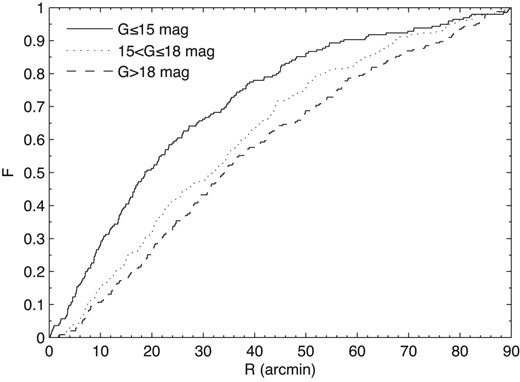
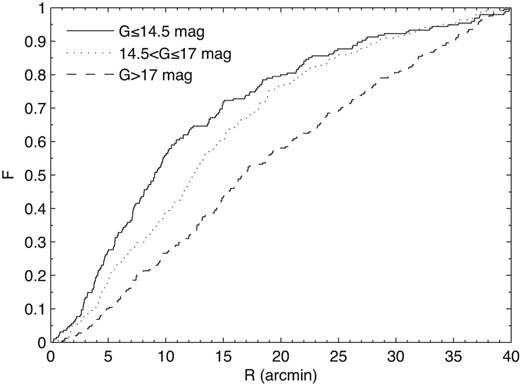
| Name . | R c1 (′) . | R c2 (′) . | R c3 (′) . |
|---|---|---|---|
| NGC 2281 | 5.26|$\, \pm \,$|0.10 | 12.18|$\, \pm \,$|0.59 | 16.95|$\, \pm \,$|1.60 |
| NGC 2539 | 3.75|$\, \pm \,$|0.14 | 6.26|$\, \pm \,$|0.60 | 7.94|$\, \pm \,$|0.81 |
| Name . | R c1 (′) . | R c2 (′) . | R c3 (′) . |
|---|---|---|---|
| NGC 2281 | 5.26|$\, \pm \,$|0.10 | 12.18|$\, \pm \,$|0.59 | 16.95|$\, \pm \,$|1.60 |
| NGC 2539 | 3.75|$\, \pm \,$|0.14 | 6.26|$\, \pm \,$|0.60 | 7.94|$\, \pm \,$|0.81 |
*Rc1, Rc2, and Rc3 indicate the core radii for the high-mass, medium-mass, and low-mass stars, respectively (see text for details).
| Name . | R c1 (′) . | R c2 (′) . | R c3 (′) . |
|---|---|---|---|
| NGC 2281 | 5.26|$\, \pm \,$|0.10 | 12.18|$\, \pm \,$|0.59 | 16.95|$\, \pm \,$|1.60 |
| NGC 2539 | 3.75|$\, \pm \,$|0.14 | 6.26|$\, \pm \,$|0.60 | 7.94|$\, \pm \,$|0.81 |
| Name . | R c1 (′) . | R c2 (′) . | R c3 (′) . |
|---|---|---|---|
| NGC 2281 | 5.26|$\, \pm \,$|0.10 | 12.18|$\, \pm \,$|0.59 | 16.95|$\, \pm \,$|1.60 |
| NGC 2539 | 3.75|$\, \pm \,$|0.14 | 6.26|$\, \pm \,$|0.60 | 7.94|$\, \pm \,$|0.81 |
*Rc1, Rc2, and Rc3 indicate the core radii for the high-mass, medium-mass, and low-mass stars, respectively (see text for details).
4 Distance, proper motion and radial velocity
We have determined 696 and 664 likely cluster members for NGC 2281 and NGC 2539, respectively (see subsection 2.3). Based on these cluster members, we can accurately estimate the distances and proper motions of the two clusters. However, Chen, Chen, and Shu (2004) found that most open clusters are spatially elongated, which may have a negative impact on accurate distance estimates for the two clusters. In this work, a Monte Carlo simulation technique (Gao 2019) is used to estimate the most likely distances and proper motions for the two clusters. For each cluster, only the high-probability cluster members (PRF ≥ 0.9) located in the inner region of the cluster (|$\lt 3\, R_{\rm c}$|; see section 3) are taken into account.
We randomly simulate the median parallax and proper motion of the high-probability cluster members based on their observational values and uncertainties. We repeat the simulation 100000 times, and obtain 100000 simulated median parallaxes and proper motions for each cluster (see figures 10 and 11). According to the simulated median values, the mean parallaxes of NGC 2281 and NGC 2539 are determined to be 〈π〉 = 1.8855|$\, \pm \,$|0.0066 (sd) and 0.7577|$\, \pm \,$|0.0042 mas, respectively. Note that a parallax zero point of ∼− 0.029 mas has been confirmed (Lindegren et al. 2018; Vasiliev 2018). Taking into account the parallax zero point (|$-0.029\, \pm \,$|0.043 mas; see Lindegren et al. 2018), the distances of NGC 2281 and NGC 2539 are 〈D〉 = 522|$\, \pm \,$|12 and 1271|$\, \pm \,$|70 pc, respectively. The mean proper motions of NGC 2281 and NGC 2539 are found to be (〈μαcos δ〉, 〈μδ〉) = (|$-2.947\, \pm \,$|0.014, |$-8.344\, \pm \,$|0.014) and (|$-2.335\, \pm \,$|0.007, |$-0.583\, \pm \,$|0.006) mas yr−1, respectively. In addition, we also estimate the radial velocities of the two clusters using only the high-probability cluster members (PRF ≥ 0.9) with radial velocities published in Gaia-DR2. We find that NGC 2811 and NGC 2539 have 42 and 11 high-probability cluster members with radial velocities, respectively. We randomly simulate (100000 times) the median radial velocities of the two clusters (see figure 12) and obtain 〈RV〉 = |$+20.0\, \pm \,$|0.7 and |$+29.6\, \pm \,$|0.4 km s−1 for NGC 2281 and NGC 2539, respectively.
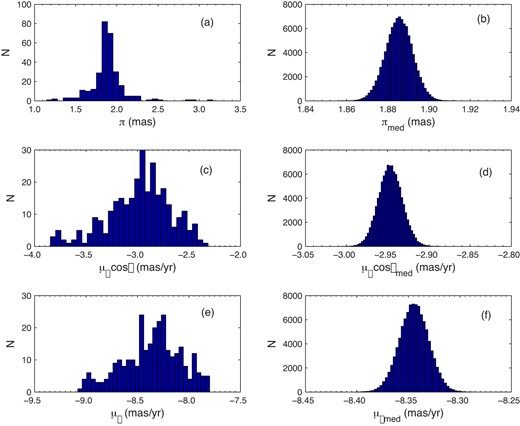
Monte Carlo simulations for the 294 high-probability cluster members in NGC 2281. Panels (a), (c), and (e) show the histograms of the observational parallaxes and proper motions (μαcos δ, μα). Panels (b), (d), and (f) show the histograms of the 100000 simulated median values. (Color online)
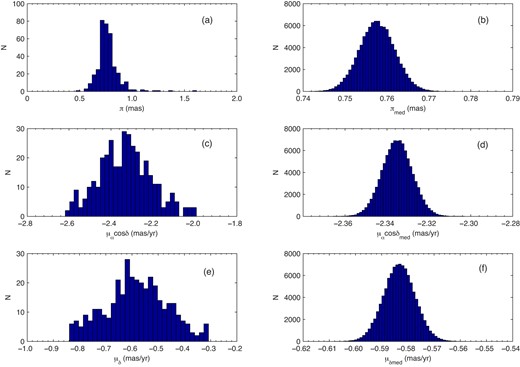
Monte Carlo simulations for the 360 high-probability cluster members in NGC 2539. Panels (a), (c), and (e) show the histograms of the observational parallaxes and proper motions (μαcos δ, μα). Panels (b), (d), and (f) show the histograms of the 100000 simulated median values. (Color online) .

Panels (a) and (b) show, respectively, the histograms of the 42 observational radial velocities and 100000 simulated median values for NGC 2281. Panels (c) and (d) show, respectively, the histograms of the 11 observational radial velocities and 100000 simulated median values for NGC 2539. (Color online)
Generally, our distances are consistent with the values in Dias et al. (2002) and Cantat-Gaudin et al. (2018). Our proper motions are also consistent with the values in Cantat-Gaudin et al. (2018), but somewhat different to those in Dias et al. (2002). However, Cantat-Gaudin et al. (2018) did not determine the radial velocities of the two clusters. Our radial velocities are also consistent with the results in Dias et al. (2002) and Soubiran et al. (2018). The study of Soubiran et al. (2018) was based on the same data as the present study (Gaia-DR2 radial velocities). Our radial velocity for NGC 2539 also agrees well with the result derived by Mermilliod and Mayor (1989). Our simulated results demonstrate that the Monte Carlo simulation technique is effective. The simulated results of the two clusters are listed in table 6.
| Name . | 〈π〉 (mas) . | 〈D〉 (pc) . | 〈μαcos δ〉 (mas yr−1) . | 〈μδ〉 (mas yr−1) . | 〈RV〉 (km s−1) . | N . |
|---|---|---|---|---|---|---|
| NGC 2281 | 1.9145|$\, \pm \,$|0.0435 | 522|$\, \pm \,$|12 | |$-2.947\, \pm \,$|0.014 | |$-8.344\, \pm \,$|0.014 | |$+20.0\, \pm \,$|0.7 | 100000 |
| NGC 2539 | 0.7867|$\, \pm \,$|0.0432 | 1271|$\, \pm \,$|70 | |$-2.335\, \pm \,$|0.007 | |$-0.583\, \pm \,$|0.006 | |$+29.6\, \pm \,$|0.4 | 100000 |
| Name . | 〈π〉 (mas) . | 〈D〉 (pc) . | 〈μαcos δ〉 (mas yr−1) . | 〈μδ〉 (mas yr−1) . | 〈RV〉 (km s−1) . | N . |
|---|---|---|---|---|---|---|
| NGC 2281 | 1.9145|$\, \pm \,$|0.0435 | 522|$\, \pm \,$|12 | |$-2.947\, \pm \,$|0.014 | |$-8.344\, \pm \,$|0.014 | |$+20.0\, \pm \,$|0.7 | 100000 |
| NGC 2539 | 0.7867|$\, \pm \,$|0.0432 | 1271|$\, \pm \,$|70 | |$-2.335\, \pm \,$|0.007 | |$-0.583\, \pm \,$|0.006 | |$+29.6\, \pm \,$|0.4 | 100000 |
*〈π〉: The zero-point-corrected parallax for the cluster. 〈D〉: The zero-point-corrected distance for the cluster. N: The number of copies of the simulation.
| Name . | 〈π〉 (mas) . | 〈D〉 (pc) . | 〈μαcos δ〉 (mas yr−1) . | 〈μδ〉 (mas yr−1) . | 〈RV〉 (km s−1) . | N . |
|---|---|---|---|---|---|---|
| NGC 2281 | 1.9145|$\, \pm \,$|0.0435 | 522|$\, \pm \,$|12 | |$-2.947\, \pm \,$|0.014 | |$-8.344\, \pm \,$|0.014 | |$+20.0\, \pm \,$|0.7 | 100000 |
| NGC 2539 | 0.7867|$\, \pm \,$|0.0432 | 1271|$\, \pm \,$|70 | |$-2.335\, \pm \,$|0.007 | |$-0.583\, \pm \,$|0.006 | |$+29.6\, \pm \,$|0.4 | 100000 |
| Name . | 〈π〉 (mas) . | 〈D〉 (pc) . | 〈μαcos δ〉 (mas yr−1) . | 〈μδ〉 (mas yr−1) . | 〈RV〉 (km s−1) . | N . |
|---|---|---|---|---|---|---|
| NGC 2281 | 1.9145|$\, \pm \,$|0.0435 | 522|$\, \pm \,$|12 | |$-2.947\, \pm \,$|0.014 | |$-8.344\, \pm \,$|0.014 | |$+20.0\, \pm \,$|0.7 | 100000 |
| NGC 2539 | 0.7867|$\, \pm \,$|0.0432 | 1271|$\, \pm \,$|70 | |$-2.335\, \pm \,$|0.007 | |$-0.583\, \pm \,$|0.006 | |$+29.6\, \pm \,$|0.4 | 100000 |
*〈π〉: The zero-point-corrected parallax for the cluster. 〈D〉: The zero-point-corrected distance for the cluster. N: The number of copies of the simulation.
5 Summary and conclusions
In this work, we aim to improve the details of the cluster members and fundamental astrophysical parameters of NGC 2281 and NGC 2539 based on the high-precision astrometric and photometric data of Gaia-DR2. The ML method (GMM+RF) allows us to identify reliable cluster members in an 11-dimensional parameter space, starting from a limited training set. The obtained reliable cluster members allow us to determine more accurate fundamental astrophysical parameters for the two clusters. Our main results and conclusions can be summarized as follows:
We obtain more complete cluster members for the two clusters. We find that the two clusters each contain more than 600 likely cluster members.
The spatial structure of the two clusters are investigated based on the obtained reliable cluster members. The core and limiting radii of the clusters are estimated (see section 3). We find that the limiting radius of NGC 2281 is significantly larger than the value derived by Kharchenko et al. (2013). In addition, we find strong evidence for the existence of significant mass segregation in the two clusters. This indicates that the two intermediate-age clusters have reached or approached dynamical relaxation.
We estimate the distances, proper motions, and radial velocities of the two cluster based on a Monte Carlo simulation technique (see section 4). Our simulated results are robust and less sensitive to outliers, since our results are derived based on the simulated median values for the high-probability cluster members located in the inner regions of the clusters. The obtained geometric distances have significantly smaller relative uncertainties (<6%). The obtained radial velocities of the two clusters are robust and reliable, even though the observational data may contain several significant outliers (see figure 12).
Acknowledgements
We thank the anonymous referee for substantial and detailed comments which greatly improved this work. This research was supported by the National Natural Science Foundation of China (NSFC, Grant No. 11403004). This work has made use of data from the European Space Agency (ESA) mission Gaia 〈https://www.cosmos.esa.int/gaia〉, processed by the Gaia Data Processing and Analysis Consortium (DPAC) 〈https://www.cosmos.esa.int/web/gaia/dpac/consortium〉. This research has made use of the VizieR catalog access tool, CDS, Strasbourg, France. This research has made use of the WEBDA database, operated at the Department of Theoretical Physics and Astrophysics of the Masaryk University.
Appendix. Fundamental parameters of likely cluster members in the two clusters
Fundamental information for the likely members of clusters NGC 2281 and NGC 2539 are shown in tables 7 and 8, respecively.
| ID . | RA (°) . | Dec (°) . | P RF . |
|---|---|---|---|
| 951483213394919808 | 102.33803612767 | +41.13296136694 | 1.000 |
| 951481083091177600 | 102.08352925624 | +41.07253947933 | 1.000 |
| 951483625711795456 | 102.22748370769 | +41.10605339959 | 1.000 |
| 951462597551931520 | 102.31908890231 | +40.86738969180 | 1.000 |
| 951459711334054528 | 102.38270767415 | +40.83971766595 | 1.000 |
| 951670400952043776 | 102.01583118264 | +41.20894889123 | 1.000 |
| 951466308403648896 | 102.47285389840 | +40.93339625154 | 1.000 |
| 951483797510477184 | 102.27000131614 | +41.14929611941 | 1.000 |
| 945468575553054592 | 102.11591972486 | +40.81670395501 | 1.000 |
| 951478536173055744 | 102.09572225891 | +41.01431216737 | 1.000 |
| 951464521697267968 | 102.29754379537 | +40.98983345407 | 1.000 |
| 951698786392577664 | 101.82486275930 | +41.57233285404 | 0.999 |
| 945469468906259328 | 101.99930676771 | +40.84967025574 | 0.999 |
| 951463353466163840 | 102.35090300698 | +40.92929419682 | 0.999 |
| 951478948489863552 | 101.98607828217 | +40.97922096312 | 0.999 |
| 951669576318384384 | 102.03325554893 | +41.19147394575 | 0.999 |
| 945464933420822912 | 101.70700962744 | +40.73059130598 | 0.999 |
| 951472729378195968 | 102.44768444542 | +41.12721879672 | 0.999 |
| 951418307849289088 | 102.58310300857 | +40.89781604617 | 0.999 |
| 951478811050907136 | 102.08050654776 | +41.04113186602 | 0.999 |
| ID . | RA (°) . | Dec (°) . | P RF . |
|---|---|---|---|
| 951483213394919808 | 102.33803612767 | +41.13296136694 | 1.000 |
| 951481083091177600 | 102.08352925624 | +41.07253947933 | 1.000 |
| 951483625711795456 | 102.22748370769 | +41.10605339959 | 1.000 |
| 951462597551931520 | 102.31908890231 | +40.86738969180 | 1.000 |
| 951459711334054528 | 102.38270767415 | +40.83971766595 | 1.000 |
| 951670400952043776 | 102.01583118264 | +41.20894889123 | 1.000 |
| 951466308403648896 | 102.47285389840 | +40.93339625154 | 1.000 |
| 951483797510477184 | 102.27000131614 | +41.14929611941 | 1.000 |
| 945468575553054592 | 102.11591972486 | +40.81670395501 | 1.000 |
| 951478536173055744 | 102.09572225891 | +41.01431216737 | 1.000 |
| 951464521697267968 | 102.29754379537 | +40.98983345407 | 1.000 |
| 951698786392577664 | 101.82486275930 | +41.57233285404 | 0.999 |
| 945469468906259328 | 101.99930676771 | +40.84967025574 | 0.999 |
| 951463353466163840 | 102.35090300698 | +40.92929419682 | 0.999 |
| 951478948489863552 | 101.98607828217 | +40.97922096312 | 0.999 |
| 951669576318384384 | 102.03325554893 | +41.19147394575 | 0.999 |
| 945464933420822912 | 101.70700962744 | +40.73059130598 | 0.999 |
| 951472729378195968 | 102.44768444542 | +41.12721879672 | 0.999 |
| 951418307849289088 | 102.58310300857 | +40.89781604617 | 0.999 |
| 951478811050907136 | 102.08050654776 | +41.04113186602 | 0.999 |
*This table contains the Gaia-DR2 identifier, positions, and RF membership probabilities for the 696 likely cluster members (≥0.6). Only a portion of this table is shown here to demonstrate its form and content; a machine-readable version of the full table is available. ID: Gaia-DR2 identifier. RA, Dec: Right ascension and declination. PRF: RF membership probability.
| ID . | RA (°) . | Dec (°) . | P RF . |
|---|---|---|---|
| 951483213394919808 | 102.33803612767 | +41.13296136694 | 1.000 |
| 951481083091177600 | 102.08352925624 | +41.07253947933 | 1.000 |
| 951483625711795456 | 102.22748370769 | +41.10605339959 | 1.000 |
| 951462597551931520 | 102.31908890231 | +40.86738969180 | 1.000 |
| 951459711334054528 | 102.38270767415 | +40.83971766595 | 1.000 |
| 951670400952043776 | 102.01583118264 | +41.20894889123 | 1.000 |
| 951466308403648896 | 102.47285389840 | +40.93339625154 | 1.000 |
| 951483797510477184 | 102.27000131614 | +41.14929611941 | 1.000 |
| 945468575553054592 | 102.11591972486 | +40.81670395501 | 1.000 |
| 951478536173055744 | 102.09572225891 | +41.01431216737 | 1.000 |
| 951464521697267968 | 102.29754379537 | +40.98983345407 | 1.000 |
| 951698786392577664 | 101.82486275930 | +41.57233285404 | 0.999 |
| 945469468906259328 | 101.99930676771 | +40.84967025574 | 0.999 |
| 951463353466163840 | 102.35090300698 | +40.92929419682 | 0.999 |
| 951478948489863552 | 101.98607828217 | +40.97922096312 | 0.999 |
| 951669576318384384 | 102.03325554893 | +41.19147394575 | 0.999 |
| 945464933420822912 | 101.70700962744 | +40.73059130598 | 0.999 |
| 951472729378195968 | 102.44768444542 | +41.12721879672 | 0.999 |
| 951418307849289088 | 102.58310300857 | +40.89781604617 | 0.999 |
| 951478811050907136 | 102.08050654776 | +41.04113186602 | 0.999 |
| ID . | RA (°) . | Dec (°) . | P RF . |
|---|---|---|---|
| 951483213394919808 | 102.33803612767 | +41.13296136694 | 1.000 |
| 951481083091177600 | 102.08352925624 | +41.07253947933 | 1.000 |
| 951483625711795456 | 102.22748370769 | +41.10605339959 | 1.000 |
| 951462597551931520 | 102.31908890231 | +40.86738969180 | 1.000 |
| 951459711334054528 | 102.38270767415 | +40.83971766595 | 1.000 |
| 951670400952043776 | 102.01583118264 | +41.20894889123 | 1.000 |
| 951466308403648896 | 102.47285389840 | +40.93339625154 | 1.000 |
| 951483797510477184 | 102.27000131614 | +41.14929611941 | 1.000 |
| 945468575553054592 | 102.11591972486 | +40.81670395501 | 1.000 |
| 951478536173055744 | 102.09572225891 | +41.01431216737 | 1.000 |
| 951464521697267968 | 102.29754379537 | +40.98983345407 | 1.000 |
| 951698786392577664 | 101.82486275930 | +41.57233285404 | 0.999 |
| 945469468906259328 | 101.99930676771 | +40.84967025574 | 0.999 |
| 951463353466163840 | 102.35090300698 | +40.92929419682 | 0.999 |
| 951478948489863552 | 101.98607828217 | +40.97922096312 | 0.999 |
| 951669576318384384 | 102.03325554893 | +41.19147394575 | 0.999 |
| 945464933420822912 | 101.70700962744 | +40.73059130598 | 0.999 |
| 951472729378195968 | 102.44768444542 | +41.12721879672 | 0.999 |
| 951418307849289088 | 102.58310300857 | +40.89781604617 | 0.999 |
| 951478811050907136 | 102.08050654776 | +41.04113186602 | 0.999 |
*This table contains the Gaia-DR2 identifier, positions, and RF membership probabilities for the 696 likely cluster members (≥0.6). Only a portion of this table is shown here to demonstrate its form and content; a machine-readable version of the full table is available. ID: Gaia-DR2 identifier. RA, Dec: Right ascension and declination. PRF: RF membership probability.
| ID . | RA (°) . | Dec (°) . | P RF . |
|---|---|---|---|
| 5727491996210260992 | 122.79607163656 | −12.75839368064 | 1.000 |
| 5727495333406159104 | 122.77221166332 | −12.71195201600 | 1.000 |
| 5727489973287041664 | 122.67577074191 | −12.82749684154 | 1.000 |
| 5727501273339613952 | 122.76746486370 | −12.68954361638 | 1.000 |
| 5727495569623956864 | 122.73989523202 | −12.71144166422 | 1.000 |
| 5727492962580743680 | 122.64966279496 | −12.81828355219 | 1.000 |
| 5727490179445451904 | 122.69797733365 | −12.79654138703 | 1.000 |
| 5727490282524648832 | 122.77028000402 | −12.84132727733 | 1.000 |
| 5727491622554445952 | 122.73328370387 | −12.78633711340 | 0.999 |
| 5727497115814392192 | 122.85356351808 | −12.74990816938 | 0.999 |
| 5727491588194718336 | 122.71963117535 | −12.80548036166 | 0.999 |
| 5727506431601749760 | 122.54512333755 | −12.72157279765 | 0.999 |
| 5727489354811757696 | 122.67585345547 | −12.84843318760 | 0.999 |
| 5727506191083568896 | 122.57435929319 | −12.72993172810 | 0.999 |
| 5726731963095795072 | 122.87230553925 | −13.03894086852 | 0.999 |
| 5727469185645395072 | 122.55763846023 | −12.85810553540 | 0.999 |
| 5727493718498559872 | 122.57800086172 | −12.79352528310 | 0.999 |
| 5727491996210261888 | 122.80209971813 | −12.76453288585 | 0.999 |
| 5727493374901139712 | 122.65105011178 | −12.78757693909 | 0.999 |
| 5727492172310238464 | 122.76505846347 | −12.74919263331 | 0.999 |
| ID . | RA (°) . | Dec (°) . | P RF . |
|---|---|---|---|
| 5727491996210260992 | 122.79607163656 | −12.75839368064 | 1.000 |
| 5727495333406159104 | 122.77221166332 | −12.71195201600 | 1.000 |
| 5727489973287041664 | 122.67577074191 | −12.82749684154 | 1.000 |
| 5727501273339613952 | 122.76746486370 | −12.68954361638 | 1.000 |
| 5727495569623956864 | 122.73989523202 | −12.71144166422 | 1.000 |
| 5727492962580743680 | 122.64966279496 | −12.81828355219 | 1.000 |
| 5727490179445451904 | 122.69797733365 | −12.79654138703 | 1.000 |
| 5727490282524648832 | 122.77028000402 | −12.84132727733 | 1.000 |
| 5727491622554445952 | 122.73328370387 | −12.78633711340 | 0.999 |
| 5727497115814392192 | 122.85356351808 | −12.74990816938 | 0.999 |
| 5727491588194718336 | 122.71963117535 | −12.80548036166 | 0.999 |
| 5727506431601749760 | 122.54512333755 | −12.72157279765 | 0.999 |
| 5727489354811757696 | 122.67585345547 | −12.84843318760 | 0.999 |
| 5727506191083568896 | 122.57435929319 | −12.72993172810 | 0.999 |
| 5726731963095795072 | 122.87230553925 | −13.03894086852 | 0.999 |
| 5727469185645395072 | 122.55763846023 | −12.85810553540 | 0.999 |
| 5727493718498559872 | 122.57800086172 | −12.79352528310 | 0.999 |
| 5727491996210261888 | 122.80209971813 | −12.76453288585 | 0.999 |
| 5727493374901139712 | 122.65105011178 | −12.78757693909 | 0.999 |
| 5727492172310238464 | 122.76505846347 | −12.74919263331 | 0.999 |
*This table contains the Gaia-DR2 identifier, positions, and RF membership probabilities for the 664 likely cluster members (≥0.6). Only a portion of this table is shown here to demonstrate its form and content; a machine-readable version of the full table is available. ID: Gaia-DR2 identifier. RA, Dec: Right ascension and declination. PRF: RF membership probability.
| ID . | RA (°) . | Dec (°) . | P RF . |
|---|---|---|---|
| 5727491996210260992 | 122.79607163656 | −12.75839368064 | 1.000 |
| 5727495333406159104 | 122.77221166332 | −12.71195201600 | 1.000 |
| 5727489973287041664 | 122.67577074191 | −12.82749684154 | 1.000 |
| 5727501273339613952 | 122.76746486370 | −12.68954361638 | 1.000 |
| 5727495569623956864 | 122.73989523202 | −12.71144166422 | 1.000 |
| 5727492962580743680 | 122.64966279496 | −12.81828355219 | 1.000 |
| 5727490179445451904 | 122.69797733365 | −12.79654138703 | 1.000 |
| 5727490282524648832 | 122.77028000402 | −12.84132727733 | 1.000 |
| 5727491622554445952 | 122.73328370387 | −12.78633711340 | 0.999 |
| 5727497115814392192 | 122.85356351808 | −12.74990816938 | 0.999 |
| 5727491588194718336 | 122.71963117535 | −12.80548036166 | 0.999 |
| 5727506431601749760 | 122.54512333755 | −12.72157279765 | 0.999 |
| 5727489354811757696 | 122.67585345547 | −12.84843318760 | 0.999 |
| 5727506191083568896 | 122.57435929319 | −12.72993172810 | 0.999 |
| 5726731963095795072 | 122.87230553925 | −13.03894086852 | 0.999 |
| 5727469185645395072 | 122.55763846023 | −12.85810553540 | 0.999 |
| 5727493718498559872 | 122.57800086172 | −12.79352528310 | 0.999 |
| 5727491996210261888 | 122.80209971813 | −12.76453288585 | 0.999 |
| 5727493374901139712 | 122.65105011178 | −12.78757693909 | 0.999 |
| 5727492172310238464 | 122.76505846347 | −12.74919263331 | 0.999 |
| ID . | RA (°) . | Dec (°) . | P RF . |
|---|---|---|---|
| 5727491996210260992 | 122.79607163656 | −12.75839368064 | 1.000 |
| 5727495333406159104 | 122.77221166332 | −12.71195201600 | 1.000 |
| 5727489973287041664 | 122.67577074191 | −12.82749684154 | 1.000 |
| 5727501273339613952 | 122.76746486370 | −12.68954361638 | 1.000 |
| 5727495569623956864 | 122.73989523202 | −12.71144166422 | 1.000 |
| 5727492962580743680 | 122.64966279496 | −12.81828355219 | 1.000 |
| 5727490179445451904 | 122.69797733365 | −12.79654138703 | 1.000 |
| 5727490282524648832 | 122.77028000402 | −12.84132727733 | 1.000 |
| 5727491622554445952 | 122.73328370387 | −12.78633711340 | 0.999 |
| 5727497115814392192 | 122.85356351808 | −12.74990816938 | 0.999 |
| 5727491588194718336 | 122.71963117535 | −12.80548036166 | 0.999 |
| 5727506431601749760 | 122.54512333755 | −12.72157279765 | 0.999 |
| 5727489354811757696 | 122.67585345547 | −12.84843318760 | 0.999 |
| 5727506191083568896 | 122.57435929319 | −12.72993172810 | 0.999 |
| 5726731963095795072 | 122.87230553925 | −13.03894086852 | 0.999 |
| 5727469185645395072 | 122.55763846023 | −12.85810553540 | 0.999 |
| 5727493718498559872 | 122.57800086172 | −12.79352528310 | 0.999 |
| 5727491996210261888 | 122.80209971813 | −12.76453288585 | 0.999 |
| 5727493374901139712 | 122.65105011178 | −12.78757693909 | 0.999 |
| 5727492172310238464 | 122.76505846347 | −12.74919263331 | 0.999 |
*This table contains the Gaia-DR2 identifier, positions, and RF membership probabilities for the 664 likely cluster members (≥0.6). Only a portion of this table is shown here to demonstrate its form and content; a machine-readable version of the full table is available. ID: Gaia-DR2 identifier. RA, Dec: Right ascension and declination. PRF: RF membership probability.
Footnotes
References



